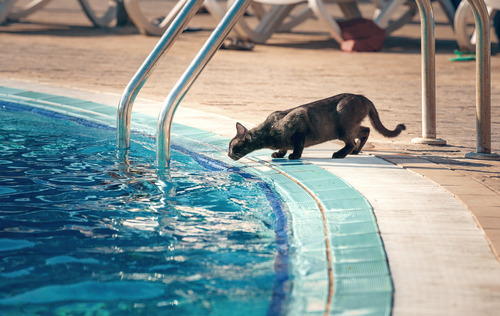Many pet owners have asked themselves at some point, “Can cats swim?” It’s a question that might bring to mind images of a cat frantically paddling in water. While it’s commonly believed that cats detest water, the truth about their swimming abilities may surprise you. In this blog, we’ll explore whether cats can swim, how some cats feel about water, and what precautions you should take if you decide to introduce your cat to swimming. If you’re looking to learn more or have concerns about your cat’s health and well-being, Boulder Veterinary Hospital in Boulder, CO, is here to help. Call us at (303) 442-6262 or book an appointment online for personalized advice and care.
The Swimming Abilities of Cats
Contrary to popular belief, cats possess the innate ability to swim. This skill is not unique to any particular breed, although some breeds show more affinity towards water than others. Cats’ bodies are surprisingly well-adapted to swimming, with their flexible spines and strong limbs allowing them to paddle efficiently in water. However, whether a cat chooses to swim or not largely depends on their individual personality and past experiences with water.
Introducing Your Cat to Water
If you’re curious about introducing your cat to swimming, it’s important to do so gradually and safely. Begin by letting them explore shallow water in a controlled environment, always supervising to ensure their comfort and security. Observing your cat’s reaction to water can be a good indicator of whether they might enjoy swimming.
Why Some Cats Dislike Water
Despite their ability to swim, many cats have a notorious aversion to water. This dislike can stem from a variety of reasons, including the weight of their wet fur, the unfamiliar sensation of being immersed in water, or negative past experiences. Understanding your cat’s perspective on water can help you better accommodate their preferences and needs.
Keeping Your Cat Safe Around Water
While cats can naturally swim, not all of them enjoy water, and even those that do can face dangers if not properly supervised. Before introducing your cat to swimming or if you have any concerns about their reaction to water, talk to your vet. They can provide advice tailored to your cat’s health, breed, and temperament. Here’s how you can ensure your cat stays safe around water:
- Supervised, Gradual Introduction: Always supervise your cat the first few times they’re near water, but start small. A shallow dish or a bathtub with minimal water can help them get used to the sensation of being wet without overwhelming them. This allows you to gauge their comfort level and intervene if they become anxious or start to struggle.
- Use of Life Vests: For deeper water scenarios, such as pools, consider a cat-sized life vest. This can provide an additional layer of safety, especially for cats that are not strong swimmers or are experiencing water for the first time.
- Check Water Temperature: Ensure the water is a comfortable temperature. Too cold and it can shock their system; too warm, and it might be unpleasant or even harmful. Cats prefer temperatures similar to their own body heat, around 100°F, but slightly cooler water is usually safer for swimming activities.
- Secure Pool Areas: If you have a pool, make sure it’s securely fenced or covered when not in use. Cats can accidentally fall into pools and struggle to get out if they’re not familiar with how to exit. Providing a ramp or steps that lead out of the pool can be a lifesaver.
- Watch for Hazards: Natural bodies of water can contain hazards like strong currents, hidden debris, or toxic algae. Always inspect the area first before allowing your cat to explore or swim.
- Recognize Stress Signals: Know the signs of stress in your cat, such as meowing loudly, clawing to get away, or rapid breathing. If your cat shows any of these signs, remove them from the water immediately and allow them to calm down in a safe, dry place.
- Dry Your Cat Thoroughly: After your cat has been in water, dry them thoroughly with a towel. This is important not only for their comfort but also to prevent chill and skin conditions that can arise from staying wet for too long. Pay special attention to their ears and paws.
Benefits and Considerations of Swimming for Cats
Swimming can offer several benefits for cats, including exercise and relief from the heat. However, it’s important to weigh these benefits against your cat’s comfort and safety. For some cats, the stress of being in water can outweigh the potential positives. Always prioritize your cat’s well-being and consult with a professional at Boulder Veterinary Hospital if you’re unsure.
When to Consult Your Vet
If you’re considering introducing your cat to swimming or have noticed any changes in their behavior or health related to water, consulting with a veterinarian is wise. At Boulder Veterinary Hospital, we’re committed to supporting you and your pet through every new adventure. Call us at (303) 442-6262 or book an appointment online to discuss the best approach for your cat’s health and happiness.
Navigating Water Safety with Your Cat
While cats can swim, not all of them will want to. Understanding and respecting your cat’s preferences, along with ensuring their safety, are key steps in exploring new activities with them. Whether you’re interested in learning more about your cat’s abilities or need professional advice, Boulder Veterinary Hospital is here to assist you. Feel free to reach out to us for any questions or to schedule an appointment for your beloved pet.





